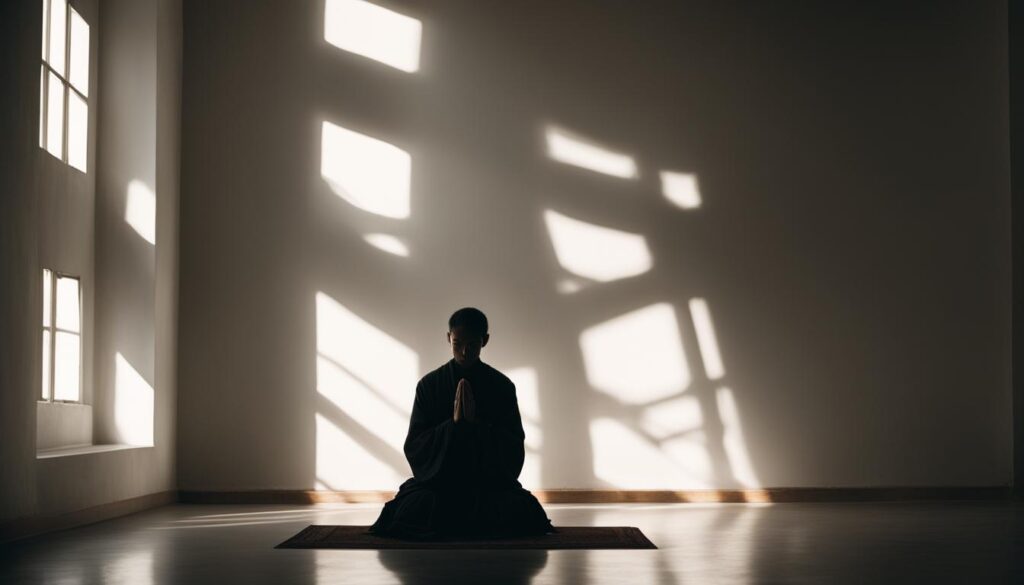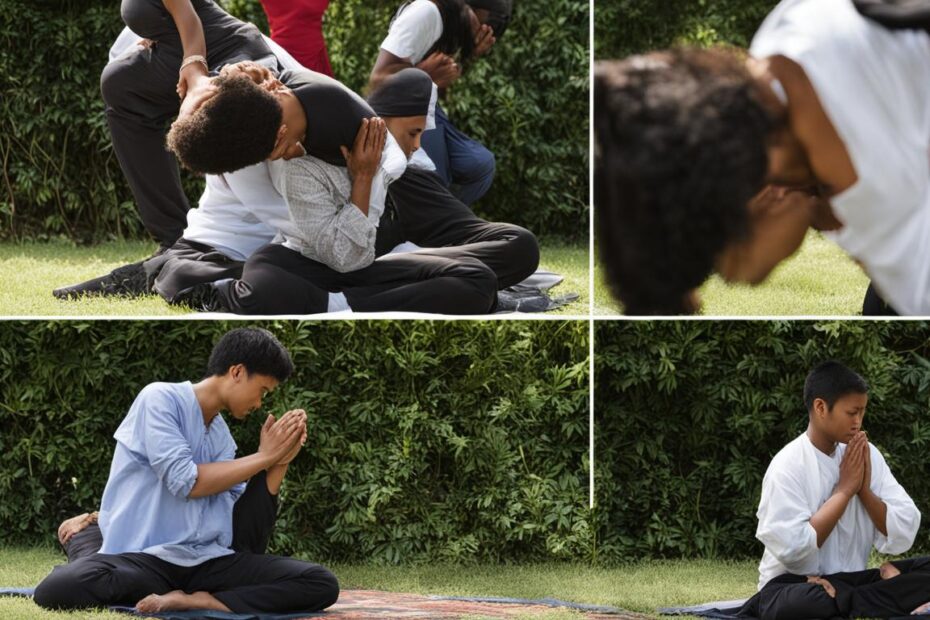Prayer is our lifeline to God, and the postures we adopt during prayer can have a significant impact on our spiritual connection. Throughout the Bible, we find various prayer postures that are seen as a means to express worship, humility, and submission to God.
Key Takeaways:
- Prayer postures play a vital role in expressing honor, respect, and reverence for God.
- Bowing before God signifies worship and submission, demonstrating humility and respect for His authority.
- Kneeling during prayer symbolizes humility and recognition of God’s authority.
- Lying prostrate in prayer is a posture of complete surrender and desperation before God.
- Lifting our hands in prayer signifies total surrender, worship, and praise to God.
The Importance of Prayer Postures
Prayer postures hold great significance in our spiritual connection with God. They serve as physical expressions of honor, respect, and reverence for the divine. While these postures can elevate our prayers and help us focus our intentions, it is crucial to remember that the posture of our hearts and the content of our prayers hold even greater importance to God.
By adopting different prayer postures, we can engage our entire being in worship and submission. Each posture carries its own unique symbolism and offers a distinct avenue for spiritual connection. Whether we bow, kneel, prostrate, lift our hands, or assume a silent posture, these physical expressions can deepen our devotion to God and enhance our prayer experience.
“The posture of the body during prayer is a reflection of the posture of the heart.”
The Significance of Honoring God in Prayer
When we assume prayer postures, we demonstrate our commitment to honoring God. These intentional physical acts serve as reminders of His authority and our dependence on Him. By bowing before God, we acknowledge His sovereignty and humbly submit ourselves to His will. Kneeling symbolizes our deep humility and recognition of our own inadequacies in the presence of the Almighty.
Lifting our hands in prayer signifies our surrender and our desire to receive God’s blessings. Closing our eyes or lifting our eyes to heaven helps us focus our thoughts and eliminate distractions, allowing for a deeper connection with God. And in moments when words fail us, a silent posture enables us to listen to God in the silence of our hearts.
Ultimately, the significance of prayer postures lies in their ability to align our physical selves with our spiritual intentions. They serve as outward expressions of our inner faith and devotion to God, enriching our prayer experience and deepening our spiritual connection.
| Prayer Posture | Symbolism |
|---|---|
| Bowing | Worship and submission to God’s authority |
| Kneeling | Humility and recognition of God’s authority |
| Lying Prostrate | Complete surrender and desperation for God |
| Outstretched Arms | Surrender and praise to God |
| Eyes Closed or Lifted | Focus and reliance on God |
| Silent Posture | Wordless plea and acknowledgement of God’s presence |
Bowing Before God
Bowing before God is a humble and reverent posture that signifies our worship and submission to His authority. Throughout the Bible, we see numerous examples of individuals bowing before God as an expression of their faith and humility. This physical act of lowering oneself before God demonstrates our recognition of His greatness and our dependence on His mercy and grace.
In Psalm 95:6, it is written, “Come, let us bow down in worship, let us kneel before the Lord our Maker.” Bowing in prayer allows us to humble ourselves before God, acknowledging His sovereignty and our need for His guidance and intervention. It is a way to show honor and reverence, offering ourselves completely to Him.
One of the notable instances of bowing in prayer is found in the story of Daniel. When faced with the decree to worship only King Darius, Daniel continued to pray to God with his windows open, disregarding the consequences. In Daniel 6:10, it says, “Now when Daniel learned that the decree had been published, he went home to his upstairs room where the windows opened toward Jerusalem. Three times a day he got down on his knees and prayed, giving thanks to his God, just as he had done before.” Daniel’s commitment to bowing in prayer, even in the face of adversity, exemplifies the significance of this posture in expressing unwavering faith and trust in God.

Biblical Examples of Bowing in Prayer:
- Abraham bowed before the Lord to negotiate for the safety of Sodom and Gomorrah (Genesis 18:22-33).
- Moses bowed in worship and obedience to God’s commands (Exodus 34:8).
- Joshua bowed before the Commander of the Lord’s army (Joshua 5:13-15).
- King David bowed in prayer and worship (2 Samuel 7:18).
- Jesus bowed in the Garden of Gethsemane, surrendering to the Father’s will (Matthew 26:39).
Bowing before God in prayer is an act of humility and surrender, allowing us to demonstrate our reverence and trust in Him. It is a tangible way to express our worship and invite His presence into our lives. While the physical posture is important, it is ultimately the condition of our hearts and our genuine desire to honor and submit to God that truly matters in prayer.
Kneeling Before God
Kneeling is a posture of humility and surrender in prayer, signifying our recognition of God’s authority and our dependence on Him. This physical act of lowering ourselves before God allows us to humble our hearts and focus our minds on His presence. Kneeling can intensify our prayers and help us enter into a deeper connection with God.
In the Bible, we find numerous examples of kneeling in prayer. One such example is Daniel, who knelt before God three times a day, even when facing persecution. King Solomon also knelt in prayer when he dedicated the temple to God, acknowledging his own unworthiness before the Almighty.
By adopting the posture of kneeling, we demonstrate our willingness to submit to God’s will and seek His guidance. It is a physical expression of our humility and reverence for the Creator of the universe. Kneeling before God allows us to set aside our own agendas and align ourselves with His perfect plan for our lives.
Benefits of Kneeling in Prayer
The act of kneeling in prayer offers several benefits for our spiritual lives:
- Humility: Kneeling reminds us of our smallness in comparison to God and helps us cultivate a humble heart.
- Focus: Kneeling helps us direct our thoughts and attention solely on God, eliminating distractions and allowing for a deeper connection.
- Intimacy: By physically bowing before God, we position ourselves to enter into a closer relationship with Him, fostering intimacy in our prayers.
- Honor: Kneeling is a way to honor God and acknowledge His greatness, acknowledging His rightful place as Lord of our lives.
As we kneel before God in prayer, let us remember that it is not just the physical posture that matters, but the attitude of our hearts. May we approach Him with humility, reverence, and a sincere desire to align ourselves with His perfect will.
| Example | Bible Reference |
|---|---|
| Daniel | Daniel 6:10 |
| Solomon | 1 Kings 8:54 |
The Power of Prostrating in Prayer: Desperation for God

When words fail and our hearts are burdened, there is a posture of prayer that speaks volumes without uttering a single word – prostrating. Lying flat on the ground, face down, this position symbolizes a deep sense of desperation for God’s intervention, mercy, and guidance. It is an act of complete surrender, acknowledging our profound need for His divine presence and assistance.
Prostrating in prayer is not merely a physical gesture; it is a profound expression of faith and trust in God’s power to answer our heartfelt cries. Throughout history, individuals like Moses, Joshua, and Elijah exhibited this posture during pivotal moments of seeking God’s intervention. Their acts of prostration conveyed their utter dependence on God and their recognition of His sovereignty.
“In my distress I called to the Lord; I cried to my God for help. From his temple he heard my voice; my cry came before him, into his ears.” – Psalm 18:6 (NIV)
This powerful posture of prayer cultivates a deep sense of humility within us. As we physically lower ourselves before God, we acknowledge His greatness and our own insignificance in comparison. It allows us to release our burdens, fears, and anxieties into His loving hands, trusting that He will provide comfort, guidance, and solutions.
Benefits of Prostrating in Prayer
Prostrating in prayer offers a range of benefits that go beyond the physical act itself. It allows us to:
- Connect with our innermost emotions and vulnerabilities, surrendering them to God.
- Deepen our humility and reliance on God’s wisdom and guidance.
- Experience a profound sense of awe and reverence for God’s majesty.
- Quiet our minds and hearts, creating space for God’s voice to be heard.
- Express our desperation and longing for God’s intervention in our lives and the lives of others.
- Find solace, comfort, and peace in the presence of our Heavenly Father.
In times of deep distress, when our words fail us, prostrating in prayer becomes a powerful way to communicate with God. It is an act of desperation, a physical manifestation of our unwavering faith in God’s ability to hear and answer our prayers.
| Benefits of Prostrating in Prayer | Scripture Reference |
|---|---|
| Connect with our innermost emotions and vulnerabilities, surrendering them to God | Psalm 55:22 |
| Deepen our humility and reliance on God’s wisdom and guidance | James 4:10 |
| Experience a profound sense of awe and reverence for God’s majesty | Psalm 145:3 |
| Quiet our minds and hearts, creating space for God’s voice to be heard | 1 Kings 19:12 |
| Express our desperation and longing for God’s intervention | Psalm 34:17-18 |
| Find solace, comfort, and peace in the presence of our Heavenly Father | Philippians 4:6-7 |
Outstretched Arms in Prayer
Lifting our hands in prayer is a powerful posture that signifies our surrender and total reliance on God. It is a physical expression of our trust in His power and a way to seek His mercy and blessing. Throughout the Bible, we see examples of individuals lifting their hands in prayer, emphasizing their openness and vulnerability before God.
When we lift our hands, we acknowledge that we cannot control or manipulate our circumstances, but instead place our faith in God’s sovereignty. It is a posture that invites His presence into our lives, allowing Him to work in and through us. As the psalmist writes in Psalm 63:4, “I will lift up my hands in your name.”
By extending our arms toward heaven, we demonstrate our longing for a deeper connection with God. It is an act of worship and praise, as we declare His greatness and magnify His name. It is a posture that reminds us to release our burdens and surrender our will to His divine plan. As we lift our hands in prayer, we invite the Holy Spirit to move in our hearts and align our desires with God’s purposes.

Lifting Our Hands: A Biblical Practice
“Hear the voice of my pleas for mercy when I cry to you for help, when I lift up my hands toward your most holy sanctuary.” – Psalm 28:2
Throughout the Bible, we find numerous instances where individuals lifted their hands in prayer. In Exodus 17:11-12, we read about Moses holding up his hands in intercession for the Israelites during battle. As long as his hands were lifted, the Israelites were victorious. When Moses became weary and his hands grew tired, Aaron and Hur came alongside him, holding up his hands to ensure their nation’s triumph.
Another example is found in 1 Timothy 2:8, where Paul encourages believers to pray with lifted hands, stating, “I desire then that in every place the men should pray, lifting holy hands without anger or quarreling.” This verse emphasizes the importance of a pure heart and unity among believers, as they come together in prayer.
Lifting our hands in prayer is a physical action that engages our whole being, transforming our inward posture and allowing us to connect with God on a deeper level. It is a beautiful expression of our surrender, trust, and dependence on Him.
The Power of Posture: Closed Eyes or Lifted Eyes in Prayer
When engaging in prayer, the position of our eyes can greatly influence our focus and connection with God. For some, closing their eyes during prayer allows them to shut out distractions and turn their attention inward, creating a space for deep reflection and communion with the divine. It is a way to center oneself and block out the external world, honing in on the spiritual realm. By closing our eyes, we can better concentrate on our prayers and open our hearts to God’s guidance and presence.
On the other hand, lifting our eyes in prayer offers a different perspective. It symbolizes a sense of trust, humility, and expectation as we direct our gaze towards heaven. By lifting our eyes, we acknowledge that our help comes from above and that we are dependent on God’s mercy and provision. It is a posture of surrender and vulnerability, signaling our reliance on His wisdom and guidance. By lifting our eyes in prayer, we demonstrate our hope and anticipation for God’s response to our heartfelt supplications.
Both closed eyes and lifted eyes in prayer serve as powerful tools to enhance our focus, sincerity, and connection with God. Whether we choose to close our eyes or lift them towards heaven, the key is to find a posture that helps us quiet our minds, center our hearts, and align our spirits with God’s presence. Each of these postures has its unique benefits and can be practiced according to personal preference and spiritual needs.
The Power of Posture: Closed Eyes or Lifted Eyes in Prayer
| Position | Benefits |
|---|---|
| Closed Eyes |
|
| Lifted Eyes |
|
Ultimately, the position of our eyes in prayer is a personal choice and may vary depending on the circumstances and the individual’s spiritual journey. Whether we choose to close our eyes or lift them towards heaven, what truly matters is the posture of our hearts and the sincerity of our prayers. As we seek to deepen our connection with God, let us mindfully consider the power of posture and the ways it can enhance our spiritual experience.

Silent Posture of Prayer
Sometimes the deepest prayers are the ones that are not spoken at all. In the silent posture of prayer, words are set aside, and a wordless plea is offered up to God. This form of prayer allows us to quiet our minds and open our hearts to listen for God’s still, small voice.
Silent prayer can be a powerful way to connect with God on a deeper level. It is a time of surrender, where we let go of our own agendas and simply abide in the presence of the Divine. In the silence, we find solace, comfort, and a sense of peace that transcends understanding.
“Be still and know that I am God.” – Psalm 46:10
Silent prayer is not about finding the right words or saying the right things. It is about creating space for God to work in our lives. It is a time of trust and vulnerability, where we allow ourselves to be fully known and loved by our Creator. In the silence, we can offer our worries, fears, and burdens to God, knowing that He hears our every cry and carries us through.
The Power of Silent Posture of Prayer
The power of silent posture of prayer lies in its simplicity and authenticity. It is a form of prayer that surpasses language barriers and cultural differences. It is a universal way of communing with God that transcends words.
In the silence, we can find healing, guidance, and renewal. We can experience a profound sense of connection with God and with ourselves. It is in these quiet moments that our souls are replenished, and our spirits are uplifted.

As we embrace the silent posture of prayer, let us remember that our hearts are the loudest when they are silent. In the absence of words, God hears the deepest longings of our souls and responds with love and grace. So, let us find solace in the silence and allow God to speak to us in ways beyond our understanding.
The Role of the Physical Body in Prayer
Prayer is not just a mental exercise; it engages our entire being, including our physical bodies. Incorporating the body in prayer can deepen our spiritual connection and bring a sense of mindfulness and presence to our worship. By engaging our senses and physical postures, we can enhance our prayer experience and cultivate a more holistic connection with God.
When we pray, our bodies can serve as instruments of worship, helping us to express our devotion, humility, and surrender. Through different postures and movements, we can physically demonstrate our reverence for God and our dependence on Him. Just as our hearts and minds are engaged in prayer, so too can our bodies be vessels for communicating with the divine.
Praying with the senses involves intentionally engaging our physical senses during prayer. For example, we can light candles or burn incense to create a sacred ambiance, allowing our sense of smell to evoke a deeper sense of presence. We can also incorporate gentle movements, like swaying or gentle stretching, to help center ourselves and align our bodies with our intentions.
| Prayer Practice | Suggested Sensory Engagement |
|---|---|
| Kneeling | Feel the pressure on your knees and palms, a physical reminder of surrender and humility. |
| Prostrating | Feel the weight of your body pressing down, symbolizing complete surrender to God. |
| Lifting Hands | Feel the release of tension as you lift your hands towards heaven, expressing surrender and praise. |
| Listening Prayer | Close your eyes and focus on the sounds around you, allowing them to guide your prayers and create a sense of stillness. |
Incorporating the body in prayer is not about performance or rigid rituals; it is about engaging our whole selves in worship. It is a way to connect with God on a deeper level, using our physical form to express the depths of our hearts. By being present in our bodies during prayer, we can cultivate a greater awareness of God’s presence and experience a more intimate and transformative communion with Him.
Embracing the Body in Prayer
In our journey of prayer, it is essential to recognize and embrace the body as a sacred vessel through which we connect with God. By accepting our bodies as God’s creation, we can cultivate a deeper sense of reverence and humility in our prayer practice. Embracing the body in prayer involves understanding the significance of our physical postures and engaging our senses in worship.
When we pray, our bodies have the ability to convey our intentions, emotions, and devotion to God. The various prayer postures we adopt, such as bowing, kneeling, or lifting our hands, can serve as physical expressions of our surrender, submission, and praise. These postures remind us of our dependence on God and create a tangible connection between our physicality and spirituality.
Additionally, incorporating our senses in prayer can deepen our experience of worship. As we close our eyes, we can shut out external distractions and turn our focus inward, creating a space of intimacy with God. This allows us to listen to His voice and be present in His presence. Alternatively, lifting our eyes to heaven can symbolize our trust and expectancy as we wait upon God to answer our prayers.
By embracing our bodies in prayer, we honor the truth that we are fearfully and wonderfully made by God. Our bodies are not to be rejected or worshipped, but rather acknowledged as vessels through which we commune with our Creator. As we cultivate this holistic perspective, we can deepen our spiritual connection and experience a profound sense of unity between our physical and spiritual selves.
Table: Incorporating the Body in Prayer
| Posture | Meaning |
|---|---|
| Bowing | Expresses humility and reverence before God |
| Kneeling | Signifies submission and recognition of God’s authority |
| Lifting Hands | Demonstrates surrender, worship, and praise to God |
| Closed Eyes | Aids concentration and creates a deeper internal focus |
| Lifted Eyes | Symbolizes reliance and hope in God’s provision |
Conclusion
Exploring different prayer postures can greatly enhance our spiritual connection with God. Whether we choose to bow, kneel, prostrate, lift our hands, or adopt a silent posture, the intentionality and humility of our hearts are what truly matter in prayer. By incorporating our physical bodies in prayer, we can deepen our relationship with God and experience a more holistic connection to the divine.
Prayer postures serve as powerful tools in expressing our worship, reverence, and submission to God. They elevate our prayers and help us focus our intentions. However, it is essential to remember that the posture of our hearts and the content of our prayers hold greater importance to God.
As we explore prayer postures, let us not forget that our spiritual connection with God is not confined to a specific physical position or gesture. It is a lifelong journey of seeking His presence, surrendering our hearts, and growing in faith. May we continuously strive to deepen our spiritual connection with God through prayer, embracing both the diversity of prayer postures and the unity of our shared desire to draw closer to Him.
FAQ
What are prayer postures?
Prayer postures refer to the physical positions or gestures we use during prayer to express worship, humility, and submission to God.
Why are prayer postures important?
Prayer postures show honor, respect, and reverence for God, elevating our prayers and helping us focus our intentions. However, it is important to remember that the posture of our hearts and the content of our prayers hold greater importance to God.
What does bowing before God signify?
Bowing before God is a biblical posture that signifies worship and submission. It demonstrates humility and respect for God’s authority.
What does kneeling during prayer symbolize?
Kneeling during prayer symbolizes humility and recognition of God’s authority. It is a common posture for many believers and can help focus and intensify prayers.
What does prostrating in prayer mean?
Prostrating, or lying flat on the ground, is a posture of complete surrender and desperation before God. It shows our need for His mercy and help.
What does lifting our hands in prayer signify?
Lifting our hands in prayer signifies total surrender, worship, and praise to God. It is a physical demonstration of our trust in His power and a way to seek His mercy and blessing.
Should I close my eyes during prayer?
Closing our eyes during prayer helps us concentrate and eliminate distractions, allowing for a deeper connection with God. Alternatively, lifting our eyes to heaven shows reliance and dependence on God, waiting in hope for His answer.
Can prayers be silent?
Yes, there are times when words fail us, and a silent prayer becomes a powerful communication with God. This posture allows us to listen to God and acknowledge His presence.
What is the role of the physical body in prayer?
The physical body plays an important role in prayer, as it engages all our senses. Practices like yoga and mindfulness meditation can deepen our prayer experience by involving the body and allowing for a more holistic connection with God.
Should Christians embrace their bodies in prayer?
Yes, Christians are called to embrace their bodies as part of their worship of God. The body is not to be worshipped or rejected but viewed as a vessel for prayer and as a reminder of our humility and dependence on God.








